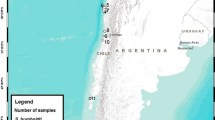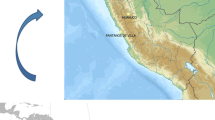Abstract
The past few years have been marked by a drastic increase in pathogen spillover events. However, the extent and taxonomic range at which these events take place remain as crucial unanswered questions in many host–pathogen systems. Here, we take advantage of opportunistically sampled bird carcasses from the South Island of New Zealand, with the aim of identifying Plasmodium spp. infections in native and endemic New Zealand seabird species. In total, six samples from five bird species were positive for avian malaria, including four of which were successfully sequenced and identified as Plasmodium matutinum LINN1 lineage. These results provide new Plasmodium infection records in seabirds, including the first documented case in Procellariiformes in New Zealand, highlighting the potential disease risk to these species.

Similar content being viewed by others
Data availability
Data is provided within the manuscript and supplementary information files.
References
Agüero M, Monne I, Sánchez A, Zecchin B, Fusaro A, Ruano MJ, ..., Orejas JJ (2023) Highly pathogenic avian influenza A(H5N1) virus infection in farmed minks, Spain, October 2022. Euro Surveill 28(3):2300001. https://doi.org/10.2807/1560-7917.ES.2023.28.3.2300001
Alley M, Hale K, Cash W, Ha H, Howe L (2010) Concurrent avian malaria and avipox virus infection in translocated South Island saddlebacks (Philesturnus carunculatus carunculatus). N Z Vet J 58:218–223
Alley MR, Hunter SA, Webster T (2019) An outbreak of avian malaria in yellow-eyed penguins, Megadyptes antipodes. Kokako 26:21–22
Atkinson CT, Samuel MD (2010) Avian malaria Plasmodium relictum in native Hawaiian forest birds: epizootiology and demographic impacts on ‘Apapane Himatione sanguinea. J Avian Biol 41:357–366
Banks-Leite C, Pardini R, Tambosi LR, Pearse WD, Bueno AA, Bruscagin RT, Condez TH, Dixo M, Igari AT, Martensen AC, Metzger JP (2014) Using ecological thresholds to evaluate the costs and benefits of set-asides in a biodiversity hotspot. Science 345:1041–1045
Bensch S, Hellgren O, Pérez-Tris J (2009) MalAvi: A public database of malaria parasites and related heamosporidians in avian hosts based on mitochondrial cytochrome b lineage. Mol Ecol Resour 9:1353–1358
Castro I, Howe L, Tompkins DM, Barraclough RK, Slaney D (2011) Presence and seasonal prevalence of Plasmodium spp. in a rare endemic New Zealand passerine (tieke or Saddleback, Philesturnus carunculatus). J Wildl Dis 47:860–867
Cloutier A, Mills J, Yarrall J, Baker A (2011) Plasmodium infections of red-billed gulls (Larus scopulinus) show associations with host condition but not reproductive performance. J R Soc N Z 41:261–277
Cunningham A (1996) Disease risks of wildlife translocations. Conserv Biol 10:349–353
Darriba D, Taboada GL, Doallo R, Posada D (2012) jModelTest 2: more models, new heuristics and parallel computing. Nat Methods 30:772
Daszak P, Cunningham A, Hyatt A (2000) Emerging infectious diseases of wildlife - threats to biodiversity and human health. Science 287:443–449
Ewen JG, Bensch S, Blackburn TM, Bonneaud C, Brown R, Cassey P, Clarke RH, Pérez-Tris J (2012) Establishment of exotic parasites: the origins and characteristics of an avian malaria community in an isolated island avifauna. Ecol Lett 15:1112–1119
Filion A, Deschamps L, Niebuhr CN, Poulin R (2022) Anthropogenic landscape alteration promotes higher disease risk in wild New Zealand avian communities. PLoS ONE 17(3):e0265568
Filion A, Webster T, Poulin R, Godfrey SS (2023) Interannual patterns of avian diseases in wild New Zealand avifauna near conservation areas. Austral Ecol 48:1413–1425
Guidon S, Gascuel O (2003) A simple, fast, and accurate algorithm to estimate large phylogenies by maximum likelihood. Syst Biol 52:696–704
Gulliver E, Hunter S, Howe L, Castillo-Alcala F (2022) The pathology of fatal avian malaria due to Plasmodium elongatum (GRW6) and Plasmodium matutinum (LINN1) infection in New Zealand kiwi (Apteryx spp.). Animals 12:3376
Heard MJ, Smith KF, Ripp KJ, Berger M, Chen J, Dittmeier J, Goter M, Mcgarvey ST, Ryan E (2013) The threat of disease increases as species move toward extinction. Conserv Biol 27:1378–1388
Hellgren O, Waldenström J, Bensch S (2004) A new PCR assay for simultaneous studies of Leucocytozoon, Plasmodium, and Haemoproteus from avian blood. J Parasitol 90:797–802
Hof C, Araujo MB, Jetz W, Rahlbek C (2011) Additive threats from pathogens, climate and land-use change for global amphibian diversity. Nature 480:516–519
Howe L, Castro IC, Schoener ER, Hunter S, Barraclough RK, Alley MR (2012) Malaria parasites (Plamodium spp.) infecting introduced, native and endemic New Zealand birds. Parasitol Res 110:913–923
Huelsenbeck JP, Ronquist F (2001) MRBAYES: Bayesian inference of phylogenetic trees. Bioinformatics 17:754–755
Hunter SA (2015) Avian malaria caused by Plasmodium elongatum in a Fiordland crested penguin. Kokako 22:21–22
Krammer F, Schultz-Cherry S (2023) We need to keep an eye on avian influenza. Nat Rev Immunol 23:267–268. https://doi.org/10.1038/s41577-023-00868-8
Lapointe DA, Atkinson CT, Samuel MD (2012) Ecology and conservation of avian malaria. Ann N Y Acad Sci 1249:211–226
Lymbery AJ, Morine M, Kanani HG, Beatty SJ, Morgan DL (2014) Co-invaders: the effects of alien parasites on native hosts. Int J Parasitol 3:171–177
Meister SL, Richard OK, Hoby S, Gurtner C, Basso WU (2021) Fatal avian malaria in captive Atlantic puffins (Fratercula arctica) in Switzerland. Int J Parasitol: Parasit Wildl 14:97–106
Miller MA, Pfeiffer W, Schwartz T (2010) Creating the CIPRES Science Gateway for inference of large phylogenetic trees Gateway Computing Environments Workshop (GCE). LA, USA, New Orleans, pp 1–8
Niebuhr CN, Blasco-Costa I (2016) Improving detection of avian malaria from host blood: a step towards a standardised protocol for diagnostics. Parasitol Res 115:3905–3911
Niebuhr CN, Poulin R, Tompkins DM (2016) Is avian malaria playing a role in native bird decline in New Zealand? Testing the hypotheses along an elevational gradient. PLoS ONE 11:e0165918
Rambaut A, Drummond AJ, Xie D, Baele G, Suchard MA (2018) Posterior summarization in Bayesian phylogenetics using tracer 1.7. Syst Biol 67:901–904
Robertson HA, Baird KA, Elliott GP, Hitchmough RA, McArthur NJ, Makan TD, Miskelly CM, O’Donnell CJF, Sagar PM, Scofield RP, Taylor GA, Michel P (2021) Conservation status of birds in Aotearoa New Zealand, 2021. New Zealand Threat Classification Series 36. Wellington, New Zealand
Roche B, Dobson AP, Guégan JF, Rohani P (2012) Linking community and disease ecology: the impact of biodiversity on pathogen transmission. Philos Trans R Soc Lond B Biol Sci 367:2807–2813
Schoener ER, Banda M, Howe L, Castro IC, Alley MR (2014) Avian malaria in New Zealand. NZ Vet J 62:189–198
Schoener ER, Tompkins DM, Parker KA, Howe L, Castro I (2020) Presence and diversity of mixed avian Plasmodium spp. infections in introduced birds whose distribution overlapped with threatened New Zealand endemic birds. N Z Vet J 68:101–106
Sijbranda DC, Campbell J, Gartrell BD, Howe L (2016) Avian malaria in introduced, native and endemic New Zealand bird species in a mixed ecosystem. N Z J Ecol 40:72–79
Smith KF, Sax DE, Lafferty KD (2006) Evidence for the role of infectious disease in species extinction and endangerment. Conserv Biol 20:1349–1357
Spottiswoode N, Bartlett SL, Conley KJ, Seimon TA, Griffin DO, Sykes JM (2020) Analysis of Plasmodium lineages identified in captive penguins (Sphenisciformes spp.), eiders (Somateria spp.), and Inca terns (Larosterna inca) in a North American zoological collection. J Zoo Wildl Med 51:140
Suzán G, García-Peña GE, Castro-Arellano I, Rico O, Rubio AV et al (2015) Metacommunity and phylogenetic structure determine wildlife and zoonotic infectious disease patterns in time and space. Eco Evol 5:865–873
Svensson-Coelho M, Silva GT, Santos SS, Miranda LS, Araújo-Silva LE, Ricklefs RE, Miyaki CY, Maldonado-Coelho M (2016) Lower detection probability of avian plasmodium in blood compared to other tissues. J Parasitol 02:559–561
Tabak MA, Piaggio AJ, Miller RS, Sweitzer RA, Ernest HB (2017) Anthropogenic factors predict movement of an invasive species. Ecosphere 8:e01844
Tompkins DM, Gleeson DM (2006) Relationship between avian malaria distribution and an exotic invasive mosquito in New Zealand. J R Soc N Z 36:51–62
Tompkins DM, Poulin R (2006) Biological invasions in New-Zealand p. 67–82. Parasites and biological invasions. Springer-Verlag, Berlin Heidelberg, p 461
Tompkins DM, Carver S, Jones ME, Krkošek M, Skerratt LF (2015) Emerging infectious diseases of wildlife: a critical perspective. Trends Parasitol 31:149–159
Valente L, Etienne RS, Garcia-R JC (2019) Deep macroevolutionary impact of humans on New Zealand’s unique avifauna. Curr Biol 29:2563–2569
Valkiūnas G, Ilgunas M, Bukauskaite D, Palinauskas V, Bernotiene R, Iezhova TA (2017) Molecular characterization and distribution of Plasmodium matutinum, a common avian malaria parasite. Parasitology 144:1726–1735
Van Riper III C, Van Riper SG, Goff ML, Laird M (1986) The epizootiology and ecological significance of malaria in Hawaiian land birds. Ecol Monogr 56:327–344
Veltman CJ, Nee S, Crawley MJ (1996) Correlates of introduction success in exotic New Zealand birds. Am Nat 147:542–557
Wilkinson DA, Marshall JC, French NP, Hayman DTS (2018) Habitat fragmentation, biodiversity loss and the risk of novel infectious disease emergence. J R Soc Interface 15:20180403
Wood MJ, Cosgrove CL, Wilkin TA, Knowles SCL, Day KP, Sheldon BC (2007) Within-population variation in prevalence and lineage distribution of avian malaria in blue tits, Cyanistes caeruleus. Mol Ecol 16:3263–3273
Acknowledgements
This project was supported by a collaboration between Komiti Taoka Tuku Iho, the Department of Conservation, Dunedin Wildlife Hospital, Otago Museum, and researchers from the Otago University. We thank and acknowledge mana whenua and local rūnanga (Te Rūnanga o Ōtākou, Te Rūnanga o Moeraki, and Kāti Huirapa Rūnaka ki Puketeraki) for their support in our disease screening process of local seabirds around Otago. We are grateful to Francois Tumahai and Te Rūnanga o Ngāti Waewae for access to Westland Petrel samples and other bird species collected in their takiwā. We thank the Department of Conservation’s Conservation Services Programme for access to seabird specimens collected through Wildlife Management International Limited (WMIL) as part of the Department’s necropsy programme, and staff at WMIL, particularly Biz Bell. We also thank the Dunedin Wildlife Hospital and Wildlife Management International for the use of their facilities and access to deceased specimens. Thanks to Tania King and Bronwen Presswell for their support in the lab, Laryssa Howe for feedback on local case studies, and Robert Poulin for his supervisory support of JB and AF during this project.
Funding
JB was supported through the Cawthron Institute’s Ministry of Business, Innovation and Employment, Emerging Aquatic Diseases Endeavour grant, award number CAWX2207. CNN was supported by a Strategic Science Investment Funding from the New Zealand Ministry of Business, Innovation and Employment awarded to Manaaki Whenua – Landcare Research. AF was supported by a grant from the New Zealand Department of Conservation.
Author information
Authors and Affiliations
Contributions
JB and AF conceived the idea. JB, CNN, CL, KLM, TW, and AF designed the study. JB and AF collected the data and wrote the first draft of the manuscript. All authors were involved in data analyses, contributed critically to the drafts, and gave final approval for publication.
Corresponding author
Ethics declarations
Ethical approval
This work complies with the New Zealand Department of Conservation permit 65658-DOA to hold and dissect deceased New Zealand birds.
Consent to participate
This study does not involve human research in any means. As such, no consent to participate is needed.
Consent for publication
All authors have agreed in the publication of the data collected. As this study does not involve human research, no consent from individuals is needed.
Competing interests
The authors declare no competing interests.
Additional information
Section Editor: Konstans Wells
Publisher's Note
Springer Nature remains neutral with regard to jurisdictional claims in published maps and institutional affiliations.
Supplementary information
Below is the link to the electronic supplementary material.
Rights and permissions
Springer Nature or its licensor (e.g. a society or other partner) holds exclusive rights to this article under a publishing agreement with the author(s) or other rightsholder(s); author self-archiving of the accepted manuscript version of this article is solely governed by the terms of such publishing agreement and applicable law.
About this article
Cite this article
Bennett, J., Niebuhr, C.N., Lagrue, C. et al. New insights into avian malaria infections in New Zealand seabirds. Parasitol Res 123, 184 (2024). https://doi.org/10.1007/s00436-024-08210-4
Received:
Accepted:
Published:
DOI: https://doi.org/10.1007/s00436-024-08210-4




